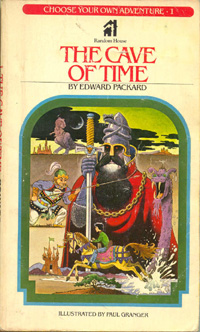The other day, Ben’s recent post on the “Novel Twists” and the “exquisite corpse” got us talking for a minute or two, on some children books loosely based on the “exquisite corpse.” The conversation got me reminiscing about other forms of children’s books that pushed the conventions of the book while remaining within confines of the printed page. In retrospect, as we gain clarity on the present and near future of digital books, I appreciate how for years, authors felt a need to overcome the limitations of the print book. While these books are not digital they do add interactivity to the experience, by both exploring interfaces and giving over some control to the reader.
Here is a quick run down of a few examples. (The format takes a cue from Ben’s post on the networked book.)

Mix and Match
Based on the idea of the “exquisite corpse,” these spiral bound books allow readers to combine various pages to creating their own images. In this example, the reader invents new dinosaurs, complete with remixed names. The spiral binding encourages the idea of ever turning pages. Thus, this non-linear book is not designed to be read front to back, but rather it is designed to be played with.

Pop – Up Book
My earliest memory of a pop-up book was from “Star Wars,” this gem from the late 70s is still available on ebay. Mark Hiner, a self-described “Paper Engineer” has build a great website on pop-up books, showing samples, an historical overview of pop-up books, as well as, instructions on creating your own. Pop-Up Books break the conventions of the static two dimensional page. Although, they still read linearly, pop-up books break into three dimensions, and add interactivity by including tabs to pull which create movement in a pop-up figure.

Choose Your Adventure
These pre-cursors to hyper-linked fiction were a big fad when they were first published in the late 70s and early 80s. In these books, readers are presented with the opportunity to chose the direction of the narrative. After a situation is described over a few pages, the reader is offered paths in a forking narrative. Each choice had a different page number, and the reader went to the correct page and proceeded with his selected narrative. I spent many hours reading and re-reading books from this classic series. In what was most likely my first attempt to “game the system” I recall finding an “ending” I liked, and working backwards to figure out how to get there. Reading in this way also lead to my first experience at reading a book backwards.
I have many memories of reading these kinds of books. Print books of this nature, however, are inevitably regulated to the realm of children. As I grew older and my reading became more “sophisticated,” the books I read stopped including these innovative features. In the case of fiction, pictures and illustrations were also eventually eliminated. Although, I do understand the idea that at times, visuals can become a crutch, which allow authors to become lazy with their writing. I must further admit that I was pleased to see visual representations of handwriting and letters from a “hangman” game included in David Mitchell’s Black Swan Green, a “serious” work of fiction. They were used sparingly and appropriately. Perhaps, the author felt these breaks in formalism were allowed as a special case because the book’s narrator is a thirteen year old boy.
I find it wonderfully ironic that we can look at these books for children for insight on the transition from printed page to screen, even-though these examples are still bounded by the technology of paper. By reflecting upon spiral binding, 3D pages, and hyper-linked pages, we are informed as we move further into the digital. What will the result be as mix and match books closer towards the original Surrealist game, where readers can include their own “parts?” How will pop-up books evolve with the integration of sound and video? Which hyper-linked fiction work, foreshadowed by Choose Your Adventure books, will become the first New York Times best seller?
if:book
A Project of the Institute for the Future of the Book
